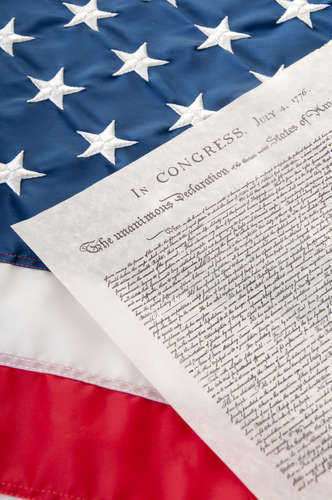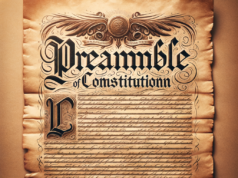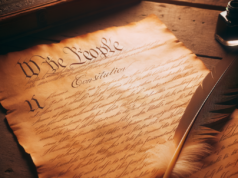
The 25th Amendment to the United States Constitution was enacted on February 10, 1967, after a period of political uncertainty arising from the assassination of President John F. Kennedy in 1963. The amendment lays out rules for the transfer of power in the event of a president’s death, resignation, or incapacity. It also clarifies the procedures for filling vacancies in the vice presidency, and establishes a mechanism by which the president can transfer power temporarily to the vice president if the president becomes temporarily unable to perform his or her duties. The 25th Amendment is a crucial component of the United States Constitution, designed to ensure stability and continuity in government during times of crisis.
Section 1 of the 25th Amendment establishes that the vice president becomes the president in the event of the president’s death or resignation. This provision has been invoked three times in U.S. history. The first instance was in 1974, when Vice President Gerald Ford became president following the resignation of Richard Nixon. The second instance was in 1981, when Vice President George H.W. Bush became president following the assassination attempt on President Ronald Reagan. The third instance was in 2021, when Vice President Kamala Harris became president following the resignation of President Donald Trump after the storming of the Capitol.
Section 2 of the 25th Amendment outlines the process for filling a vacancy in the vice presidency. The president nominates a replacement, subject to confirmation by both houses of Congress. This has happened eight times in U.S. history, most recently in 2021, when Vice President Harris was replaced by Senator Alex Padilla of California.
Section 3 of the 25th Amendment provides a mechanism for the president to transfer power temporarily to the vice president if the president becomes unable to perform his or her duties. This might occur if the president is undergoing surgery, receiving treatment for a serious illness, or otherwise incapacitated. The president can transfer power to the vice president by submitting a written declaration to the speaker of the House of Representatives and the president pro tempore of the Senate. The vice president becomes acting president until the president is able to resume his or her duties.
Section 4 of the 25th Amendment provides for the removal of the president if he or she becomes incapacitated but is unable or unwilling to relinquish power. This provision has never been invoked in the history of the United States. However, some scholars have suggested that this provision may eventually be used to remove a president who is incapacitated but refuses to voluntarily relinquish power.
The 25th Amendment has played a crucial role in U.S. history, ensuring that the government continues to function smoothly even in times of crisis. However, its scope is not restricted to political emergencies alone. It has influenced the development of state-level policies and laws through its section 4, which allows the vice president and a majority of the cabinet to declare the president unfit for office. This provision has been replicated in various state constitutions across the country since the 1970s, reflecting its importance in safeguarding the country’s democratic processes.
For instance, in California, the state constitution was amended in 1974, requiring the lieutenant governor and a majority of the state cabinet to declare the governor unfit for office. This provision has been replicated in states such as Illinois, New Jersey, and Oregon, demonstrating the 25th Amendment’s far-reaching influence. These state-level provisions underscore the importance of ensuring that an elected official remains capable of performing their duties in order to ensure efficient governance and democratic accountability.
The 25th Amendment’s provisions have also influenced broader legislative efforts aimed at protecting the democratic process. For instance, the Presidential Succession Act of 1947 established the line of succession for the presidency, placing the Speaker of the House and the President Pro Tempore of the Senate after the vice president. Similarly, the National Emergencies Act of 1976 established a process by which the president can declare a national emergency, though this power is subject to Congressional oversight.
In addition to its unique focus on contingency planning, the 25th Amendment is notable for its differences from similar provisions found in other countries’ constitutions. Although many democratic nations have procedures in place for the transfer of power in the event of a president’s death, resignation, or incapacitation, the 25th Amendment is notable for its specificity and comprehensiveness.
For instance, the United Kingdom’s procedures for transitional government rely more heavily on established conventions and norms than on written laws or constitutional provisions. Similarly, the Canadian constitution allows the governor-general to take over the duties of the monarch in the event of death or incapacitation, but does not have detailed provisions for the transfer of power in other situations.
Despite these differences, the 25th Amendment stands as a testament to the importance of contingency planning and continuity of government, both in the United States and around the world. Its specific provisions have played a crucial role in ensuring that the United States remains a functional democracy, capable of managing both routine transitions of power and crises alike.
The 25th Amendment would again address certain procedures regarding the offices of the President and the Vice-President. Most specifically, it entails procedures regarding the succession to the Presidency, as well as determining the process to fill a vacancy in the Vice President’s office. Further provisions also include procedures to be taken if the President is rendered incapacitated due to disabilities.
The 25th Amendment addresses an important issue that had already been a concern in previous legislation in the United States Constitution, and furthermore, actual events occurring in both the office of the President and Vice-President were confused as to how to proceed.
Though the Constitution addressed Presidential office procedures in Article II, the text proved to be ambiguous because it did not explicitly state whether the Vice President is to take the Presidential office, rather than just the position of “Acting President.” Furthermore, it did not address what procedures were to take place if the President died, resigned, or was removed from office. The 25th Amendment was ratified by the states on July 6th, 1965.
The 25th Amendment proves to be one of the most important Constitutional Amendments because it sets forth precedence in the extenuating circumstance that the President is removed from office regardless of the reason. Prior to the 25th Amendment, there was confusion regarding the procedures and who would then replace the President and to what extent that person would assume the Presidential office.
The first occurrence of this kind of situation resulted when President William Henry Harrison died while in office. Vice President John Tyler then assumed the role of President, rather than just acquiring the position’s powers and responsibilities. Tyler refused to be recognized as “Acting President” and would finally take the oath of office, making him the tenth United States President. This would become known as the “Tyler Precedent”, which would informally establish that the Vice President would take the office of President in the event that the elected President died while in office. However, no formal legislation existed establishing such a procedure.
A similar event would again occur while President Woodrow Wilson was in office and suffered a stroke. No individual formally assumed the Presidential office during that time. Furthermore, the office of Vice President has been vacated sixteen times, with no one assuming the role.
The extenuating circumstances led to the clear need for Constitutional Amendments that would create guidelines and procedures if such events were to occur, as well as delineating the exact position that the person assuming the Presidential role would have. Two proposals were sent to Congress for the new Amendment that would provide for these guidelines: the Keating-Kefauver proposal and the Bayh-Celler proposal.
The Keating-Kefauver proposal would delegate to Congress the power to determine when a President would be considered disabled, and thus, unable to carry out the responsibilities of the position. Concerns would arise dealing with the possible abuse of authority by Congress by giving them such power, and thus, this proposal was being rejected.
The Bayh-Celler proposal, which is the one on which the 25th Amendment is ultimately based, stated that the Vice President would become “Acting President” in the case the President would become disabled. It also included procedures regarding the vacancy of the Vice President’s office in such a situation.
The 25th Amendment would be divided into four distinct sections, each addressing particular procedures regarding events in which the President-elect would no longer be able to carry out the duties of the office. Section 1 would include the “Tyler Precedent” as the accepted procedure under law, in which the Vice President would assume the Presidential Office if the President were to die, be removed from office, or resign.
Section 2 states that in the case that the Vice President office is vacated, the President would appoint the person to fill that position in concurrence with a majority vote by both Houses of Congress.
Section 3 deals with the situation in which the President becomes disabled. The President must provide a written declaration to the President pro tempore of the Senate and the Speaker of the House of Representatives stating that he is unable to carry out his responsibilities. The Vice President would then serve as “Acting President” until yet another written declaration is issued by the President stating that he/she is able to resume the duties of the position.
Section 4 is the only provision that has not been implemented. This provision gives the authority to the Vice President to declare the President as disabled by submitting a written declaration to the President pro tempore of the Senate and the Speaker of the House of Representatives. This is only to occur if the President him/herself cannot provide for a written declaration due to the disability. However, if the President is not disabled to that extent, a written declaration stating that he/she is able to resume the office would reinstate him as President.
If the Vice President and the Cabinet are still dissatisfied with the condition of the President, yet another declaration can be submitted. At this juncture, Congress must meet within 48 hours if not in session. Congress must then render a two-thirds vote regarding whether or not the President is capable of carrying out the responsibilities of the office. A period of 21 days is allotted to reach such a decision. If no decision is met, the President would still remain in office. Otherwise, the Vice President would continue as “Acting President.”






















